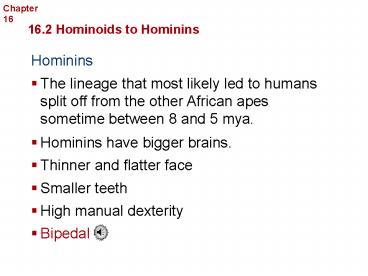Primate Evolution - PowerPoint PPT Presentation
1 / 19
Title:
Primate Evolution
Description:
Primate Evolution Chapter 16 16.2 Hominoids to Hominins Hominins The lineage that most likely led to humans split off from the other African apes sometime between 8 ... – PowerPoint PPT presentation
Number of Views:248
Avg rating:3.0/5.0
Title: Primate Evolution
1
Primate Evolution
Chapter 16
16.2 Hominoids to Hominins
Hominins
- The lineage that most likely led to humans split
off from the other African apes sometime between
8 and 5 mya.
- Hominins have bigger brains.
- Thinner and flatter face
- Smaller teeth
- High manual dexterity
- Bipedal
2
Primate Evolution
Chapter 16
16.2 Hominoids to Hominins
3
Primate Evolution
Chapter 16
16.2 Hominoids to Hominins
Why bipedalism?
- A changing environment might have played only a
minor role.
- Most successful hominins might have been those
that evolved on the edge of the forest and
savanna.
4
Primate Evolution
Chapter 16
16.2 Hominoids to Hominins
Hominin Fossils
- Australopithecines lived in the east-central and
southern part of Africa between 4.2 and 1 mya.
- Small
- Apelike brains and jaws
- Teeth and limb joints were humanlike.
5
Primate Evolution
Chapter 16
16.2 Hominoids to Hominins
Taung Baby
- The first australopithecine fossil discovered
- Australopithecus africanus likely lived between
3.3 and 2.3 mya.
Lucy
- Lucy is one of the most complete
australopithecine fossils ever found.
- She was a member of the species A. afarensis,
which lived between 4 and 2.9 mya.
6
Primate Evolution
Chapter 16
16.2 Hominoids to Hominins
Paranthropus
- Thrived between 2 and 1.2 mya
- An offshoot of the human line that lived
alongside human ancestors but were not directly
related
7
Primate Evolution
Chapter 16
16.3 Human Ancestry
The Genus Homo
- The African environment became considerably
cooler between 3 and 2.5 mya.
- Homo species had bigger brains, lighter
skeletons, flatter faces, and smaller teeth than
their australopithecine ancestors.
8
Primate Evolution
Chapter 16
16.3 Human Ancestry
- Homo habilis lived in Africa between about 2.4
and 1.4 mya.
- Brain averaged 650 cm3
- Smaller brow
- Reduced jaw
- Flatter face
- More humanlike teeth
- Small, long-armed, and retained the ability to
climb trees
9
Primate Evolution
Chapter 16
16.3 Human Ancestry
Homo habilis
10
Primate Evolution
Chapter 16
16.3 Human Ancestry
- Homo ergaster emerged within 500,000 years of H.
habilis.
- Taller
- Lighter
- Longer legs and shorter arms
- Brain averaged 1000 cm3
11
Primate Evolution
Chapter 16
16.3 Human Ancestry
Homo ergaster
12
Primate Evolution
Chapter 16
16.3 Human Ancestry
- H. ergaster appears to have been the first
African Homo species to migrate.
- Eurasian forms of H. ergaster are called Homo
erectus.
- H. erectus lived between 1.8 million and 400,000
years ago.
13
Primate Evolution
Chapter 16
16.3 Human Ancestry
Homo erectus
- Larger than H. habilis
- Brain capacity ranged from about 900 cm3 to about
1100 cm3
- Longer skull, lower forehead, thicker facial
bones, and a prominent browridge
14
Primate Evolution
Chapter 16
16.3 Human Ancestry
- Homo floresiensis lived about 18,000 years ago.
- About 1 m tall
- Brain and body proportions like all the
australopithecines.
15
Primate Evolution
Chapter 16
16.3 Human Ancestry
- Shorter but had more muscle mass
- Larger brains than modern humans
- Thick skulls, bony browridges, and large noses
16
Primate Evolution
Chapter 16
16.3 Human Ancestry
Emergence of Modern Humans
- Homo sapiens is characterized by a more slender
appearance than all other Homo species.
- Thinner skeletons, rounder skulls, and smaller
faces with prominent chins
- Their brain capacity averages 1350 cm3.
- Appeared in the fossil record, in what is now
Ethiopia, about 195,000 years ago
17
Primate Evolution
Chapter 16
16.3 Human Ancestry
Out-of-Africa Hypothesis
- 30,000 years ago, only modern humans remained.
18
Primate Evolution
Chapter 16
16.3 Human Ancestry
Mitochondrial Eve
- Mitochondrial DNA changes very little over time.
- The population with the most variation should be
the population that has had the longest time to
accumulate diversity.
- H. sapiens emerged in Africa about 200,000 years
ago from a hypothetical Mitochondrial Eve.
19
Primate Evolution
Chapter 16
16.3 Human Ancestry
Cro-Magnons
- Early modern humans expressed themselves
symbolically and artistically.
Cro-Magnon cave painting
- Developed sophisticated tools and weapons
- The first to fish, the first to tailor clothing,
and the first to domesticate animals































